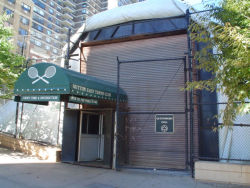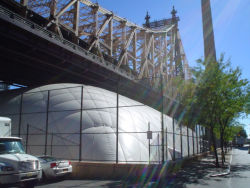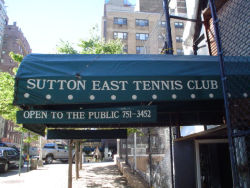Queensboro Oval
Queensboro Oval
What was here before?
This site was part of the land Governor Edmund Andros granted to John Danielson in 1676. After a series of owners, the property became Thomas C. Pearsall’s farm in the early eighteenth century. In 1809 Pearsall also acquired the deed for the Mount Vernon Hotel and property, which bordered his farm to the north. The elegant stone carriage house that accompanied the mansion remains on East 61st Street as a landmarked museum. The Mount Vernon property was leased to various tenants until Pearsall died in 1820 and it was passed to his seven children, who in turn sold the property in 1824 in what became a series of owners.
Maps show buildings lined this block in the 1890s, prior to construction of the Queensboro Bridge completed in in 1909.
How did this site become a park?
The site, bounded by York Avenue and 59th and 60th Streets, is built on land that the City of New York initially acquired in 1909 for use as an alternative bridge approach and is a City Department of Transportation property managed by NYC Parks. The site is covered by an inflatable bubble and operated as a tennis facility, which is run under a concession license. With opportunities for sport and recreation, Queensboro Oval is a thriving oasis beneath a major thoroughfare.
What is this park named for?
The Queensboro Bridge, which provides both a ceiling and a name for this park, opened in 1909, connecting Manhattan and Queens by way of an intermediary link on Roosevelt Island, was once known as Welfare Island. The two-leveled steel bridge is one of eight New York City bridges that span the East River. Designed by engineer and architect Gustav Lindenthal (1850-1935) and architect and educator Henry Hornbostel (1867-1961), it is the first major structural project to reject the suspension technique in favor of cantilevering. The upper level once carried wooden railway cars, and five-cent trolleys shared the lower level with automobiles until 1955. In addition to his work on the Queensboro Bridge, Lindenthal prepared plans for the Manhattan Bridge, helped to complete work on the Williamsburg Bridge, and directed the reconstruction of the Brooklyn Bridge. The National Register of Historic Places added the Queensboro Bridge, officially named the Ed Koch Queensboro Bridge and known as the 59th Street Bridge, to the list of City landmarks in 1978.
Check out your park's Vital Signs
Clean & Safe
Green & Resilient
Empowered & Engaged Users
Share your feedback or learn more about how this park is part of a
Vital Park System



